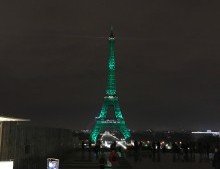
Paris held it’s peace conference, but did anything happen there? Eiffel Tower in Paris. Illustrative. By Joshua Spurlock
The Paris Peace Conference finally convened on Sunday and issued a broad declaration of plans for peace that ultimately just repeated messages that have already been spoken. Despite bringing together 70 nations, the final statement of the Paris Peace Conference as published by Haaretz provided no clear plans for obtaining peace or for restarting negotiations between the sides, with much of the specifics listed generally as the principles already expressed recently by U.S. Secretary of State John Kerry. Haaretz reported that the final statement was “less harsh” than a previous draft.
Israel had long warned the meeting would produce no results, but only encourage Palestinian intransigence by appearing tilted towards pressuring Israel. After the meeting, Israeli Foreign Ministry spokesman Emmanuel Nahshon posted to Twitter, “#ParisPeaceConference turned as flat as a failed soufflé. A big show is no replacement for direct negotiations between the parties.” The statement from the Paris Peace Conference announced plans to meet again later this year, “in order to support both sides in advancing the two-state solution through negotiations,” but no dates or additional details were given.
Prior to the release of the final statement in Paris, Israeli Prime Minister Benjamin Netanyahu had termed the conference “useless.” In comments released by his office, the Israeli leader said the conference “is being coordinated between the French and the Palestinians. Its goal is to try and force terms on Israel that conflict with our national needs. Of course it pushes peace further away because it hardens the Palestinian positions and it also pushes them away from direct negotiations without preconditions.”
Ironically, the Paris statement warned that sides should “refrain from unilateral steps that prejudge the outcome of negotiations on final status issues” such as Jerusalem and borders, and yet the statement they cited from Secretary Kerry already intimated some rough outlines of borders and laid out a general plan for Jerusalem.
Kerry mentioned the 1967 armistice line with “mutually agreed equivalent swaps” of territory as borders between the sides, according to his speech in late December that was published by the State Department website. He also called for Jerusalem to be the capital for two states with “freedom of access to the holy sites consistent with the established status quo.”
Meanwhile, the Paris plan shifted away from spelling out proposals and instead sought to emphasize cooperation. General promises of European economic opportunities and support for Palestinian civil institutions were offered as inducements to make peace, and the statement welcomed cooperation between major world powers and the Arab states in the peace effort.
It also called for both Israel and the Palestinians to “officially restate their commitment to the two-state solution, thus disassociating themselves from voices that reject this solution,” and to “independently demonstrate, through policies and actions, a genuine commitment to the two-state solution.”
Ultimately, the statement had to reaffirm the need for “meaningful direct negotiations” between the sides, a point and offer Netanyahu has been making for some time but had been virtually ignored by the French.
On Sunday, even before the conference concluded, the Israeli leader argued that it was old and out-of-touch. Said Netanyahu, “I must say that this conference is among the last twitches of yesterday’s world. Tomorrow’s world will be different—and it is very near.”
(By Joshua Spurlock, www.themideastupdate.com, January 15, 2017)
